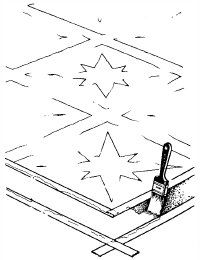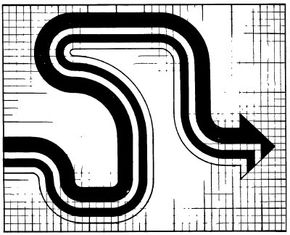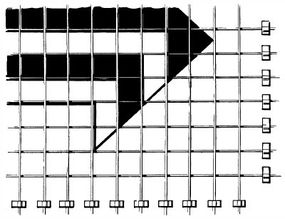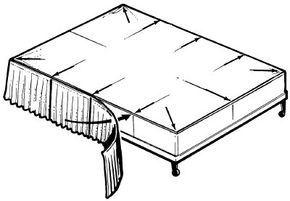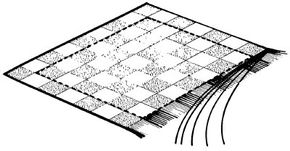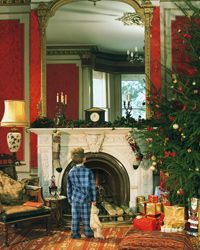For the guest room, the kids' room, or anywhere you want a special effect, a made-to-match bedspread and dust ruffle are a quick and easy answer.
Tools:
- Tape measure
- Pencil or fabric marker
- Scissors
- Straight pins
- Sewing machine
- Steam iron
- Ironing board
Materials:
- Fabric
- Thread
- Old sheet or preshrunk muslin for top panel of dust ruffle
- Covered cording
- Woven trim, or fringe, as desired
Time: 11/2 to 21/2 hours for the bedspread, 2 to 3 hours for the dust ruffle
Measuring and Buying the Fabric
To make a bedspread for a twin bed, you'll need 52/3 yards of fabric 36 to 45 inches wide; for a full-size spread, you'll need 52/3 yards of 44- or 45-inch fabric. For a king-size spread, buy 87/8 yards of 44- or 45-inch-fabric or 57/8 yards of 54- to 60-inch-wide fabric. If the fabric is very light, you may want to add a lining. An old sheet is ideal for this; if you must buy material buy inexpensive muslin. Preshrink it before you use it.
To make the dust ruffle, you'll need a panel of fabric the same size as the top of the box spring, plus 3/4 inch all around -- 39 × 753/4 inches for a twin bed, 54 × 753/4 inches for a full-size bed, or 76 × 803/4 inches for a king-size bed. This panel will be concealed between the mattress and the box spring; use an old sheet, or use preshrunk inexpensive muslin. For the ruffle itself, you'll need 41/8 yards of 44- or 45-inch fabric for a twin bed, 42/3 yards for a full-size bed, or 52/3 yards for a king-size bed.
The Bedspread
This spread is designed to be tucked in at both sides and the foot, and folded over the pillows at the head. The finished size of a twin-size spread is 66 × 100 inches; of a full-size spread, 80 × 100 inches; of a king-size spread, 102 × 105 inches. Each spread is made up of a top panel and two side panels, varied in width to fit the width of the bed.
Cutting the Bedspread: Before cutting out the pieces of the bedspread, square off the end of the fabric. Spread the fabric out on your work surface. Make a small cut into the selvage near one end, and grasp one crosswise thread. Pull this crosswise thread gently to draw it right out of the fabric, all across the width of the fabric. This will leave a line in the fabric where the thread was. Carefully cut along the pulled-thread line, and discard the crooked end.
To cut the pieces for the spread, measure down from the pulled-thread line across the fabric and mark the required length; cut each piece carefully, making sure you cut straight across the fabric. For a twin spread, cut the top piece 32 × 102 inches, and two side pieces each 18 × 102 inches. For a full-size spread, cut one piece 44 × 102 inches, and two pieces each 19 × 102 inches. For a king-size spread, cut one piece 44 × 110 inches and two pieces each 30 × 110 inches, if you have 44-or 45-inch wide fabric; for 54- to 60-inch-.wide fabric, cut one piece 54 × 110 inches and two pieces each 27 × 110 inches.
Sewing the Bedspread: When the panels are cut, assemble the spread. Place a narrow side panel over the center panel, right sides together and matched along one long edge. Pin the pieces together along the matched edge. On a sewing machine, straightstitch the pieces together along the pinned edge, 1/2 inch from the edge, backstitching to secure the ends. Remove the pins and press the seam open. Repeat, pinning and stitching, to attach the other side panel to the other side of the top panel.
When the spread is assembled, make a double 1/2-inch hem around all four sides; hem first the short sides and then the long ones. On each side of the spread, turn the raw edge under 1/2 inch and press it into place; turn it under again 1/2 inch and press again. Pin the hem into place and straight-stitch it near the inside edge, backstitching to secure the ends of the hem. Remove the pins.
Variations on the Bedspread: Vary the bedspread as you like to suit the room and the fabric. To add decorative interest, insert covered cording in the seams, as for a daybed cover; or cover the seams with woven trim. To reinforce a very light fabric, add a lining cut from an old sheet or preshrunk muslin, in panels the same size as the spread panels. Lay out the spread and lining pieces together, wrong sides together, and treat them as one layer of fabric; assemble the spread as above.
If you prefer, make a coverlet instead of a tuck-in spread to hang loosely over the dust ruffle. For a twin bed, cut the top piece 32 × 102 inches, and the two side pieces each 15 × 102 inches, for a finished size of 60 × 100 inches. For a full-size bed, cut the top piece 44 × 102 inches, and the two side pieces each 16 × 102 inches, for a finished size of 75 × 100 inches. For a king-size spread with a finished size of 97 × 105 inches, cut the top piece 44 × 110 inches and the two side pieces each 27 × 110 inches from 44- or 45-inch-wide fabric; or the top piece 54 × 110 inches and two side pieces each 24 × 110 inches from 54- to 60-inch-wide fabric. Make the spread exactly as above; if desired, round off the two bottom corners. Add fringe all around the edge, if you like.
The Dust Ruffle
The dust ruffle consists of a long strip and a panel over the box spring, as specified above.
Making the Center Panel: To make the panel, cut an old sheet to fit, or cut lengths of preshrunk muslin and seam them together to the proper width. Across one narrow end of the panel, turn the raw edge under 3/4 inch and press it; turn it under again 3/4 inch, press, and pin it into place. Stitch the hem along the inside edge, backstitching to secure the ends, and then remove the pins.
Measuring and Cutting the Ruffle: Before cutting the ruffle, square the end of the fabric, if necessary, as above; draw out a thread and cut along the pulled-thread line. Then measure and cut the ruffle fabric into panels the width of the fabric and 161/2 inches long, or the distance from the top of the box spring to the floor, plus 21/2 inches -- if this distance is more than 14 inches, you'll need wider panels, and more fabric. For a twin bed, you'll have nine panels 161/2 inches long and 44 or 45 inches wide; for a full-size bed, ten panels; for a king-size bed, twelve panels.
Making the Ruffle: To make the ruffle, sew the panels together end to end. Place two panels together, right sides together, and match the 161/2-inch selvage edges on one end. Pin the matched edges and stitch them together 5/8 inch from the edge. Remove the pins.
Open the double panel and place another panel on top of one of the two attached panels, right sides together. Pin the 161/2-inch edges together along the free end of the attached panel, and stitch them 5/8 inch from the edge, as above; remove the pins and unfold the panels. Continue this process, adding long panels accordion-style, until all the panels are stitched together end to end. Press all the seams open.
Make a double 3/4-inch hem on each narrow end and on one long side of the strip. For each hem, turn the raw edge under 3/4 inch and press it; turn it under 3/4 inch again, press, pin, and stitch the hem. Remove the pins.
Gathering the Ruffle: At the unhemmed top of the dust ruffle, gather the long edge of the strip. Loosen the upper thread tension on the sewing machine and lengthen the stitch length to make the thread easier to gather. With the ruffle right side up, make two parallel rows of stitching along the top edge, one row 5/8 inch from the edge and the other 1/4 inch above it. Break the gathering threads and start again at each end-to-end seam along the ruffle; for each section, pull the bobbin thread with one hand and slide the fabric with the other to form and adjust the gathers.
Attaching the Ruffle to the Center Panel: When the ruffle is put together and gathered, measure the distance around two sides and one end of the box spring. Divide this number by the number of panels in the dust ruffle: 9 for a twin bed, 10 for a full-size bed, or 12 for a king-size bed. This figure is the distance between seams on the completed dust ruffle, gathered on the bed.
The assembled dust ruffle is attached to the plain sheet or muslin top panel on three sides; the hemmed end of the panel is left unattached, because the dust ruffle doesn't extend around the head of the bed. Starting at the hemmed end of one long side of the panel, make marks all around the panel's raw edges at the calculated seam interval. Pin the gathered ruffle to the three raw edges of the panel right sides together, matching the seams in the ruffle to the marks on the panel. If the ruffle doesn't fit exactly, pull in or let out the gathering threads.
Reset the upper thread tension and the stitch length and stitch the ruffle to the top panel all along the pinned edges; work with the gathered fabric so you can keep tucks and pleats from forming. Backstitch to secure the ends of the seam. Remove the pins. All along the dust ruffle, snip off the long ends of the gathering threads.
Press the seam away from the ruffle. To finish the dust ruffle, topstitch along the seamed edges of the top panel, 1/8 inch from the seam, stitching through the pressed-up edges of the ruffle seam. The seam will be 5/8 inch in from the edge of the box spring, so it won't show. If you made a coverlet instead of a tuck-in spread, and added fringe to the edge of the coverlet, use fringe on the edge of the dust ruffle too.
Using the Dust Ruffle: To put the dust ruffle on the bed, slide the mattress off and position the panel on the bed, plain end at the head of the bed. Then replace the mattress and put the bedspread on.
Put your newly obtained sewing skills to use by learning how to make a tablecloth and napkins next.

